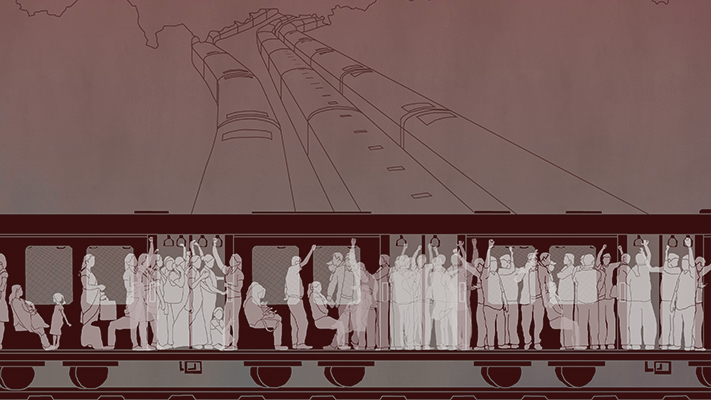PAUSE - An interpretation of Lost Spaces in the Maximum city
"Absences should not cause us to look elsewhere, but to look closer."
- Courtney J. Campbell
The Premise:
"The people of Mumbai are considered to be a chirpy, tireless lot who
are streamlined for a fast-paced life in the city” quotes a website.
However, have we zoomed in enough to find out? For a city which
attained its fame as Urbs Prima in Indis due to the railways,
a natural port, textile mills and an engineering industry, its gradual
downfall is best seen through the super dense, crush load,
in its railways, where 16 people jostle for a square meter of
space in a local train every single day! An exponential rise in
the real-estate development in Mumbai’s extended suburbs has led
to the citizens, commuting for hours to work and not in the most
favorable circumstances. The near marginalization of the middle and
working classes, long distance commutes in near sub-human conditions,
rising stress levels and lopsided development where the infrastructure
fails to match a rising population, have led to the region becoming a
simmering pot, threatening to blow up at the slightest provocation.
Amidst all the exasperation, all that a Mumbaikar needs is to PAUSE. But, where is the breather ?


Where is the breather?
The amount of open space provided in Mumbai is the lowest in any major metropolis around the world. Whereas the ideal ratio is 4 acres per thousand persons, a study conducted in 1970 showed that the actual ratio in Mumbai was a mere 0.03 acres (currently 0.013 acres) which is 270 times lesser than the norms. Despite the glaring shortage, the government has taken away more than 150 acres of open space for redevelopment purposes, and as Mumbaikars, with the constant struggle to keep our heads above the tide, we seem to have forgotten that we continue to survive in appalling conditions in the city.
Owing to Mumbai’s history of metamorphosis, will this scenario ever change?
Lost spaces as potential breathers:
A lack of ownership, negligence and stringent government policies have given rise to several spaces in the city which come under the category of urban voids or lost spaces. This list includes unsuccessful sky walks, old mill lands and under-used railway yards which have stopped functioning either partially or completely.
For example, the Mumbai Suburban railway line, that was established by the British East India Company, carries out a majority of the maintenance work of its coaches in railway yards, that have been set-up at strategic locations in the city. However, some of these yards lie underused now, due to a change in the urban context or with the establishment of other well-equipped maintenance spaces. Thus, the older yards are now turning out to be some of the darker urban voids that the city now owns, but does not know what to make of!
However, these sites could be seen as a potential solution to the lack of open public places, and their revitalization could also introduce vigor into some of our otherwise banal neighborhoods!

AUTHOR NOTE:
An excerpt from my research for the 2020 M.A.A.D. Spring Semester Studio (Narratives in Architecture ) at C.E.P.T. University.
Studio Tutor- Dr. Meghal Arya (Associate Professor, Faculty of Architecture, CEPT University)
Studio Intent- Interpreting "lost spaces" in the city.
Studio Works- https://portfolio.cept.ac.in/2020/S/fa/narratives-in-architecture-ad4005-spring-2020
CITATIONS:
Works not cited are created by Author - Saadiya Rawoot
Rawoot, Saadiya Rukhsana, Ajaz; "Interpreting lost spaces in the city”; Dr. Arya, Meghal; Narratives in Architecture, C.E.P.T. University Feb 2020 https://portfolio.cept.ac.in/2020/S/fa/narratives-in-architecture-ad4005-spring-2020/pause-spring-2020-pg180838
Rathi, Arjun: "Open Spaces Pyramid", Instagram Oct 20 2015 https://www.instagram.com/p/9D3UzEkWwL/?igshid=YmMyMTA2M2Y=
Marpakwar, Chairanya. "Extend museum, don’t take away playground: locals to Bhau Daji Lad expansion plan”;Mumbai Mirror; Dec 9, 2014; https://mumbaimirror.indiatimes.com/mumbai/other/extend-museum-dont-take-away-playground-locals-to-bhau-daji-lad-expansion-plan/articleshow/45421141.cms
Das, P. K. "Open Mumbai: Re-Envisioning the City and Its Open Spaces.” Mumbai Waterfronts Centre, 2011. https://pkdas.com/maps/9-Open-Mumbai-book.pdf
Eeshanpriya, M. S. "Mumbai to get more open space per person”; Hindustan Times; April 27 2018; https://www.hindustantimes.com/mumbai-news/mumbai-to-get-more-open-space-per-person/story-5BtDAXun2YvuEJm3pvw6NM.html
Correa, Charles. "Cities and Political Power", Indian Architect & Builder Jan, 2013 https://issuu.com/iab_archives/docs/iab_jan_2013/5
Data source for mapping: UDRI/ www.loginmumbai.com
CITATIONS:
Works not cited are created by Author - Saadiya Rawoot
Rawoot, Saadiya Rukhsana, Ajaz; "Interpreting lost spaces in the city”; Dr. Arya, Meghal; Narratives in Architecture, C.E.P.T. University Feb 2020
https://portfolio.cept.ac.in/2020/S/fa/narratives-in-architecture-ad4005-spring-2020/pause-spring-2020-pg180838
Rathi, Arjun: "Open Spaces Pyramid", Instagram Oct 20 2015 https://www.instagram.com/p/9D3UzEkWwL/?igshid=YmMyMTA2M2Y=
Marpakwar, Chairanya. "Extend museum, don’t take away playground: locals to Bhau Daji Lad expansion plan”;Mumbai Mirror; Dec 9, 2014; https://mumbaimirror.indiatimes.com/mumbai/other/extend-museum-dont-take-away-playground-locals-to-bhau-daji-lad-expansion-plan/articleshow/45421141.cms
Das, P. K. "Open Mumbai: Re-Envisioning the City and Its Open Spaces.” Mumbai Waterfronts Centre, 2011. https://pkdas.com/maps/9-Open-Mumbai-book.pdf
Eeshanpriya, M. S. "Mumbai to get more open space per person”; Hindustan Times; April 27 2018; https://www.hindustantimes.com/mumbai-news/mumbai-to-get-more-open-space-per-person/story-5BtDAXun2YvuEJm3pvw6NM.html
Correa, Charles. "Cities and Political Power", Indian Architect & Builder Jan, 2013 https://issuu.com/iab_archives/docs/iab_jan_2013/5
Data source for mapping: UDRI/ www.loginmumbai.com
Read more








